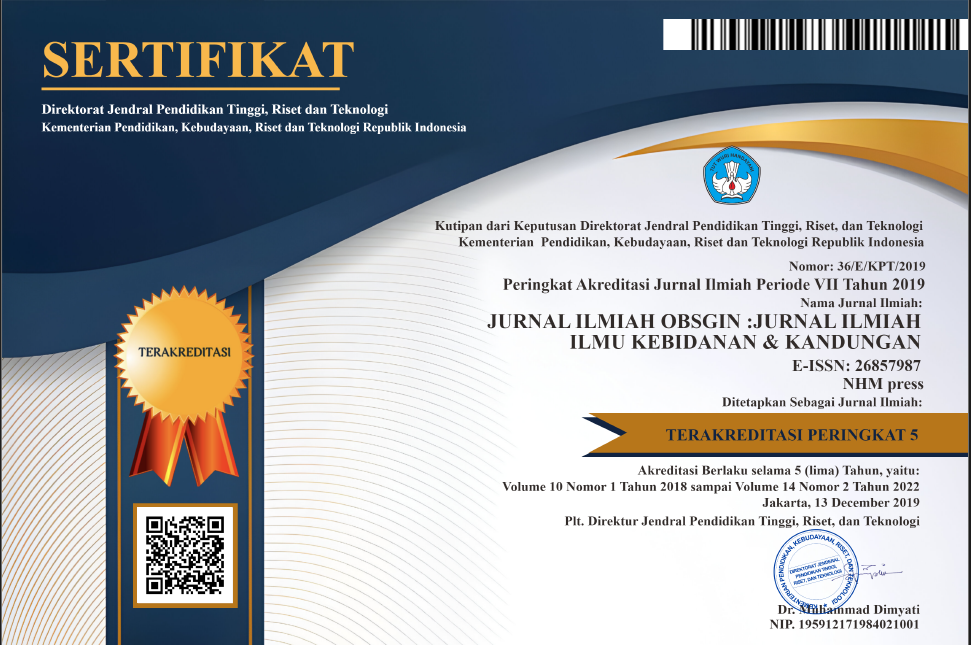ANALISIS FAKTOR LINGKUNGAN DAN KETAHANAN PANGAN DENGAN KEJADIAN STUNTING PADA ANAK USIA SEKOLAH
Abstract
The potential for a pandemic to trigger an increase in the malnutrition crisis in 2020 is that 132 million people suffer from hunger and 370 million school-age children do not receive adequate food, 47 million children are wasted and 144 million are stunted. The purpose of the study was to analyze environmental factors, maternal characteristics, and household food security with stunting in SD 22/IV and SD 87/IV Jambi City. The design of this study was cross sectional with a sample of 70 children. The sampling was stratified random sampling based on proportional allocation. Data collection techniques using questionnaires, observation sheets and anthropometry. Analysis using Chisquare test. The study found 24.3% stunting, 14.3% inadequate drinking water sources, 44.3% inadequate environmental sanitation, 47.1% low maternal nutrition knowledge and 48.5% low maternal education level, and home food security stairs during the pandemic are not safe 45.7%. There is a relationship between environmental factors, knowledge of maternal nutrition and household food security during the pandemic with the incidence of stunting in school-age children. Environmental factors, knowledge of maternal nutrition and household food security during the Covid-19 pandemic are factors related to the incidence of stunting in school-age children.
References
Dasril, O., Program, A. (, Kesehatan, S., Stikes, M., & Saintika, S. (2019). Karakteristik Keluarga terhadap Kejadian Stunting pada Anak Sekolah Dasar di Kecamatan Nanggalo Kota Padang. Jurnal Sehat Mandiri, 14(2). http://jurnal.poltekkespadang.ac.id/ojs/index.php/jsm48
Eka Puji Lestari, M., & Siwiendrayanti, A. (2021). Kontribusi Kondisi Fisik Lingkungan Rumah dengan Kejadian Diare dan Hubungannya terhadap Kejadian Stunting. https://doi.org/10.15294/ijphn.v1i3.47482
Gibney, M. J., Margetts, B. M., Kearney, J. M., & Arab, L. (2013). Gizi Kesehatan Masyarakat (M. J. Gibney, B. M. Margetts, J. M. Kearney, & L. Arab, Eds.). EGC.
Ilham, D., & Laila, W. (2018). Faktor Determinan Kejadian Stunting pada Anak Sekolah dan Pengaruhnya Terhadap Prestasi Belajar Di SDN 09 Nanggalo Kota Padang Tahun 2017. Health Journal, 5.
Kemenkes RI. (2018). Laporan Nasional RISKESDAS 2018.
Peraturan Menteri Kesehatan Republik Indonesia Nomor 2 Tahun 2020, (2020).
Kholidah, N., Zen Rahfiludin, M., Rahayuning, D., Gizi, M. P., Masyarakat, K., Diponegoro, U., & Gizi, B. (2020). Hubungan Pengetahuan dan Sikap Ibu tentang Gizi, Asupan Protein dan Seng Anak, Serta Sanitasi Rumah Terhadap Stunting Anak Sekolah Dasar. 10(2), 45–50. https://ejournal.undip.ac.id/index.php/jim/index
Lamid, A. (2015). Masalah Kependekan (Stunting) pada Anak Balita: Analisis Prospek Penanggulangannya di Indonesia. IPB Press.
Lestari, W., Rezeki, H. I., Siregar, D. M., Manggabarani, S., Gizi, D., Kesehatan Helvetia, I., Peminatan, M., Reproduksi, K., Epidemiologi, D., & Korespondensi, P. (2018). Factors Related Without Stunting on Children in Elementary School 014610 Sei Renggas West Kisaran Subdistrict Asahan District. Jurnal Dunia Gizi, 1(1), 59–64. https://ejournal.helvetia.ac.id/jdg
Nurjannah, S., & Yulfia Elsadewi Yanuartati, B. (2021). Kajian Kritis terhadap Ketahanan Pangan Rumah Tangga dan Fenomena Stunting: Kasus pada Dua Desa di Kecamatan Gunungsari Kabupaten Lombok Barat. Agrimansion, 22(3).
Octaviani, P., Dody Izhar, M., & Amir, A. (2018). Hubungan Pola Makan dan Aktivitas Fisik dengan Status Gizi pada Anak Sekolah Dasar di SD NEGERI 47/IV Kota Jambi. In Jurnal Kesmas Jambi (Vol. 2, Issue 2). JKMJ.
Oktia, N., Dokter, N., & Bsmi, R. (2020). Stunting pada Anak: Penyebab dan Faktor Risiko Stunting di Indonesia. QAWWAM: JOURNAL FOR GENDER MAINSTREAMING , 14(1), 19. https://doi.org/10.20414/Qawwam.v14i1.2372
Sekretariat Wakil Presiden RI. (2018). Strategi Nasional Percepatan Pencegahan Anak Kerdil (Stunting).
Simanjuntak, B. Y., Annisa, R., & Saputra, A. I. (2022). Mikrobiota vs Stunting pada Anak (1st ed.). CV Andi Offset.
Syafiq, A., Fikawati, S., & Gemily, S. C. (2022). Household food security during the COVID-19 pandemic in urban and semi-urban areas in Indonesia. Journal of Health, Population and Nutrition, 41(1). https://doi.org/10.1186/s41043-022-00285-y
World Bank. (2016). Child Malnutrition Estimates.
World Health Organization. (2016). Childhood Stunting: Context, Causes and Consequences. https://www.who.int/publications/m/item/childhood-stunting-context-causes-and-consequences-framework
World Health Organization and UNICEF. (2016). Regional Report on Nutrition Security in ASEAN Volume 2. https://asean.org/wp-content/uploads/2016/03/Regional-Report-on-Nutrition-Security-in-ASEAN-Volume-2.pdf
World Health Organization and UNICEF. (2022). ASEAN Food and Nutrition Security Report 2021.











